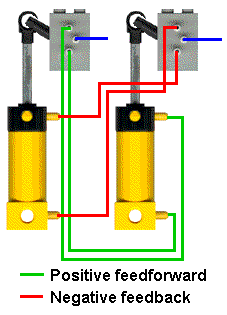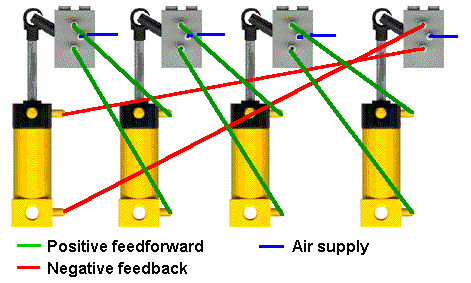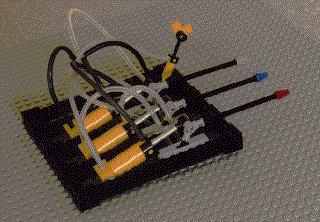
In LEGO models, pneumatics are mostly used as a power deployment system only. In industry however, pneumatics are used for control logic as well.

A basic example is the loop. Connect two cylinders and two valves like this. The second cylinder is to mimic the first one: 'if I open you open'. The first however is to contradict the first: 'if I open you close'. If constant pressure is supplied to the valves, both cylinders will cycle (open and close) automatically.
This control circuitry can be used as a seperate module to control any pneumatic model. Simply connect the cylinder(s) in the model parallel to one of the cylinders in the control block.
Alternatively, the control circuitry can be integrated
in the model itself. So one cylinder moves some part of
the model, and switches a valve as a side effect. This
valve will open another cylinder, which switches the
valve of the first one; the model part will move back
(and so on).
This is done in the alternative model of set 8868 (the
truck with pneumatic grabber) to move a grabbing arm up
and down. (Analysing this model is how I learned about
all this. It even made me study a book on industrial
pneumatic control systems.)

The loop principle can easily be extended to sequences of pneumatic actions. Just connect a series of cylinders and valves positively and connect the last one negatively to the first. All the cylinders will open one after the other, the close one after the other and so on. Interestingly, the pneumatic circuits are independent; so heavy application of one cylinder won't effect the timing and movement of the other cylinders.
To control models, it suffices to connect to either the mechanics or the pneumatics of each control module. Ofcourse, some of the cylinder-valve pairs can be integrated in the model. For example, if the third action must start after the second action has moved a mechanism to a certain point (then switching the valve). In this way, machines can be automated with some simple sensor functions.
 Note, the LEGO pneumatic valve (switch)
shows three in/outlets. But technically it is a
three-positions/four-connections valve. There is a fourth
hidden in/outlet, which can not be accessed to connect a
hose. This is unfortunate, because in logic circuitry the
fourth inlet is often used for other things than just
releasing used air.
Note, the LEGO pneumatic valve (switch)
shows three in/outlets. But technically it is a
three-positions/four-connections valve. There is a fourth
hidden in/outlet, which can not be accessed to connect a
hose. This is unfortunate, because in logic circuitry the
fourth inlet is often used for other things than just
releasing used air.
In real life industrial control, there is a wide range of pneumatic cylinders, pneumatic motors, integrated circuitry blocks, valves, sensors (even sensors that use free floatng air stream to perceive presence of objects!) and integration with electronics. I can't wait for LEGO to extend its pneumatics pieces.
Photo: Control train of three
control cylinders, and one (small) working cylinder.